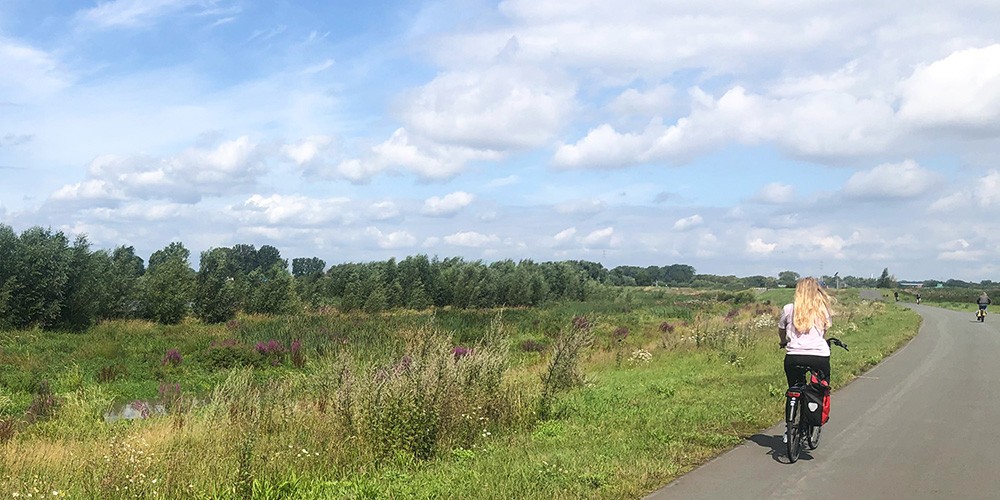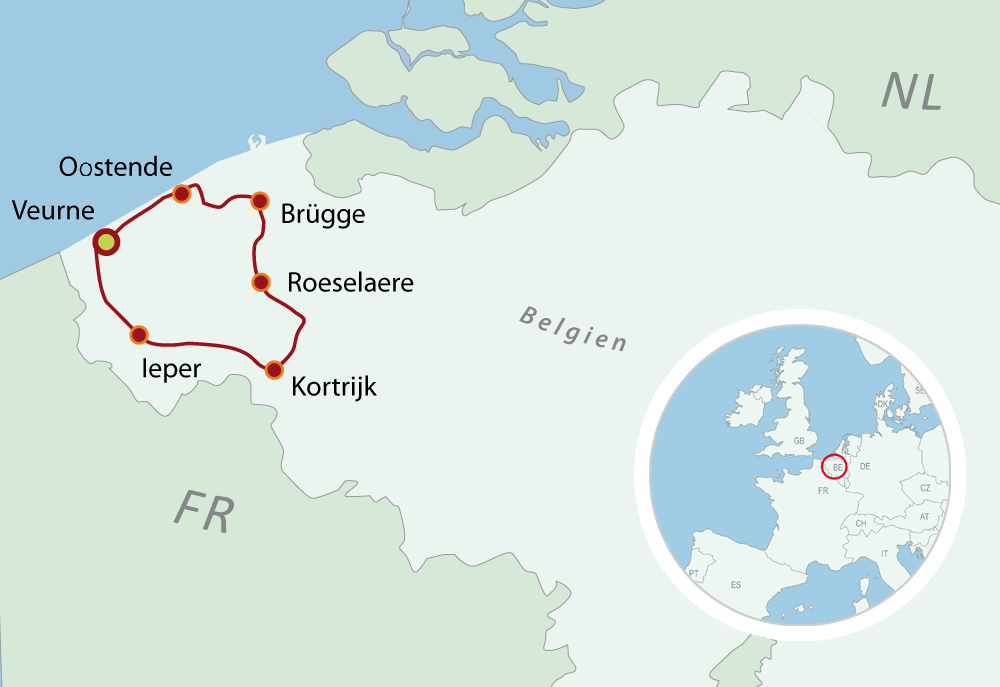Itinerary
West Flanders - Bruges, the coast and 'Flanders Fields'
8 days / 7 nights | Self-guided cycling tours
This is the first stanza of the famous poem written by John McCrae in 1915, in name of those who had died in the Great War on the West Front. However, the poem was a call to arms; and the worst was yet to come. Battlefields, museums, cemeteries and memorials can be visited on Days 06 and 07 of this tour.
Most WWI-related places of interest are situated within the Bruges – Panne - Ypres triangle. If you want to stay longer, just book an extra night.
The happy highlight of this holiday is the wonderful town of Bruges. Preserved, renovated and added to in just the right medieval look, it is a harmonious and satisfying whole - cobbles and all. It feels like a fairytale village, complete with swan lake.
Level 1: This is an easy cycling trip on relatively flat terrain, suitable for people with little or no cycling experience. Daily cycling distances span roughly 30–50 km. A 3-gear bike should suffice.
Itinerary
Day 1: Arrival Ypres
Organize your own journey to Veurne. The beauty of the small Old Town will delight you. The main market square is one of the most beautiful in all of Belgium.
Day 2: Ypres - Veurne (Cycling 58 km / 37 miles)
History buffs will have a field day at Lijssenthoek, former location of huge wartime hospitals and nowadays the final resting place for 11.000 soldiers of thirty different nationalities. Pause at the excellent visitors’ centre, a true work in progress. Cycling onward to Poperinge, art buffs will get a veritable master class in the Gothic style and gourmets can hang out at the Hops Museum, where colourful characters present Belgian beer and the culture of cultivating hops. At St Sixtus Abbey in Westvleteren, the Cistercians monks pray, read and work… in the brewery! Coming full circle, the winding roads of West Flanders find glistening streams, scattered villages and vast farmed fields on the way back to Veurne.
Day 3: Veurne - Ostend (Cycling 42 km / 26 miles)
Sail out on your bike, heading up the North Sea coast. Art lovers might like to pause at the museum dedicated to painter Paul Delvaux (1897-1994). The popular beach resort of Koksijde boasts the highest dune around, formerly a “beacon” for sailors at sea. Next is Nieuwpoort, which recalls the Dutch-Spanish battle of 1600 and the years 1914-1918 on the West Front. Top off your day with a rest in the resort town of Oostende (Ostend) and marvel as the sun sinks into the sea.
Day 4: Ostend - Bruges (Cycling 40 km / 25 miles)
Set off on a short cycling route, which ensures ample time to explore beautiful Bruges. Stop in Stalhille at a workshop beneath the church tower, where master Antonie Demonie displays his many trades as a glass-blower, basket weaver, beekeeper. Relax a bit and 'ponder the polder', while savouring a cup of honey tea or glass of honey beer. Wander through the peaceful nature reserve of Meetkerkse Moeren, open wetlands with flower-filled meadows and a habitat of poplars for bats and birds. Last but not least, the captivating town of Bruges absolutely must be admired both by day and by night. Picture-perfect!
Day 5: Bruges - Roeselaere (Cycling 58 km / 37 miles)
Strike out on a delightful longer ride through the wooded terrain of Houtland, dotted with country estates and castles with exotic names. Stop off to see those found near Oostkamp -Pecsteen, Raepenburgh and Lakebos- and make time for a visit of Torhout, Gitsberg and Hooglede. At the end of the day, set your course for Roeselaere.
Day 6: Roeselaere - Kortrijk (Cycling 35 km / 22 miles)
In 1995, work got underway to transform farmland into the Rhodesgoed Woods, first by planting of poplars and willows, later with slow-growing oak, ash, cherry and beech. 25 years later, the area provides habitat for a great number of plant and animal species, thanks in part to numerous ponds and the meandering Rhodebeek stream. For a change of pace, feed your fetish at the shoe capital of Izegem, wander the halls of Eperon d’Or Museum and learn about the town’s industrial heritage. Later, move into a country scene on slightly rolling terrain and take in the wide-open landscapes of West Flanders. Cycle to Kortrijk along the River Leie (Lys) and leave time to stroll the streets around the town hall. Whip out your camera for a shot of the belfry, beguinage, medieval Broel towers and the Gravenkapel. And entertain your fascination with colour at St. Anthony’s church, painted by the Passionist Fathers in green, brown and gold.
Day 7: Kortrijk - Ieper (Cycling42 km / 26 miles)
Let the River Leie lead you to the border town of Menen (Menin), where thousands of German soldiers lie buried at the War Cemetery. Then proceed to the Passchendaele 1917 Memorial in Beselare/Zonnebeke and stretch your legs on a 3-km walk to Tyne Cot Cemetery. See Polygon Wood, formerly the scene of fighting and home to two British war cemeteries and memorials to soldiers from Australia and New Zealand, and the Canadian Hill 62, one of the few places where trenches have been preserved. A free app aids in exploring the sites around Ypres and the town’s magnificent Lakenhalle houses an intriguing museum called “In Flanders Fields”, where every evening buglers play the 'Last Post'.
Day 8: Departure from Ypres
After breakfast, your holiday will come to an end. It’s time to return home.
Please note: All cycling distances stated above are approximate only.


